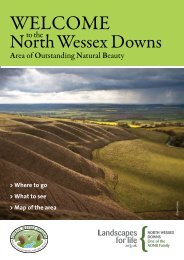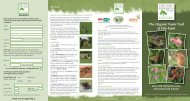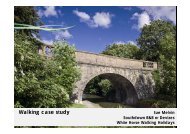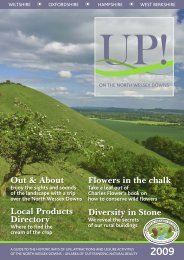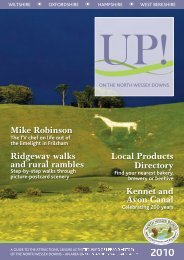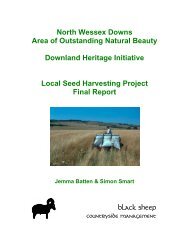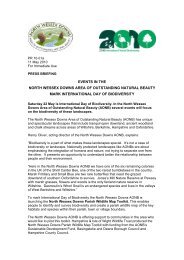UP! - North Wessex Downs Area of Outstanding Natural Beauty
UP! - North Wessex Downs Area of Outstanding Natural Beauty
UP! - North Wessex Downs Area of Outstanding Natural Beauty
You also want an ePaper? Increase the reach of your titles
YUMPU automatically turns print PDFs into web optimized ePapers that Google loves.
Things look better in the dark!<br />
“IT’S only when you get out <strong>of</strong> the towns<br />
that surround the <strong>North</strong> <strong>Wessex</strong> <strong>Downs</strong><br />
that you realise how little we normally<br />
see in the night skies,” says Daniel<br />
O’Donoghue <strong>of</strong> The Richmond Fellowship.<br />
He has been leading an AONB-funded<br />
dark skies project involving a mobile<br />
observatory and students from St John’s<br />
School and Community College in<br />
Marlborough. (Pictured. The red glow is<br />
Marlborough lighting up the sky.)<br />
“Equipped with star maps, red lights,<br />
binoculars and telescopes, we are<br />
encouraging young people to explore<br />
the night sky, beginning with their nearsky<br />
neighbour the moon, then on to the<br />
planets and beyond. The idea is that they<br />
return home understanding how the<br />
darkest sky lets you see the furthest."<br />
“The <strong>North</strong> <strong>Wessex</strong> <strong>Downs</strong> AONB is not<br />
only beautiful during the day. Its night<br />
skies are among the best in the UK.”<br />
The continuing project is investigating<br />
the impacts <strong>of</strong> light pollution on night<br />
skies. “The <strong>Downs</strong> are great places for<br />
viewing the night skies, but it’s a pity<br />
that people have to travel so far from<br />
their homes to see the sky at its best.<br />
They should be able to view it all from<br />
their doorsteps.”<br />
Dark skies in the AONB are actually<br />
legally protected by light pollution<br />
legislation, but even so the<br />
encroachment <strong>of</strong> urbanisation and<br />
careless use <strong>of</strong> lighting is reducing our<br />
dark sky areas. Protection <strong>of</strong> dark night<br />
skies is a policy objective <strong>of</strong> the <strong>North</strong><br />
<strong>Wessex</strong> <strong>Downs</strong> Management Plan.<br />
“Light is arguably the most easily<br />
solved pollutant – just turn it <strong>of</strong>f or point<br />
it downwards.”<br />
Careful use <strong>of</strong> lighting can also lower<br />
energy bills and helps reduce<br />
greenhouse gas emissions, he adds.<br />
“When you see towns on the AONB<br />
margin shooting light into the night<br />
skies, you quickly realize that it’s quite<br />
simply our biggest visible waste <strong>of</strong><br />
resources.” ■<br />
Details: 01672 516393<br />
www.richmondfellowship.org.uk<br />
“Too many people leave house lights<br />
on, or have badly directed security<br />
lighting that spills outwards and<br />
upwards. Businesses, sports<br />
floodlighting, and even streetlights<br />
add to unnecessary skyward glare.<br />
Light should only shine where it is<br />
needed and wanted.”<br />
– Daniel O’Donoghue<br />
Picture Holly O’Donoghue<br />
<strong>UP</strong>! On The <strong>North</strong> <strong>Wessex</strong> <strong>Downs</strong> | 43




